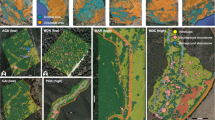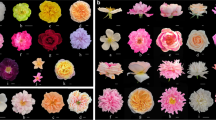Abstract
Morphometric, cytogenetic, geographical and ecological evidence for hybridization betweenParkinsonia aculeata andCercidium praecox is presented. Morphometric investigation using the character count procedure and cytogenetic observations confirm hybrid status. All diagnostic morphometric characters were intermediate in the hybrid. Both parents (2n = 28) show regular tetrad formation and pollen fertility greater than 94%. Hybrids have a chromosome number of 2n = 28 or 2n = 30, and display meiotic abnormalities including lagging chromosomes and micronucleus formation; less than 21% of hybrid pollen was fertile. Ecological and geographical information suggests that hybridization is occurring at increasing frequency due to the expanding range ofP. aculeata associated with cultivation as an ornamental, coupled with ecological disturbance and weediness, and the cultivation ofC. praecox and hybrids as fodder, ornamental and shade trees. Hybrid fertility and phenological observations, in conjunction with F-weighted principal component analysis, suggest that the progeny of F1 hybrids are established. The hybrid is formally described asP. ×carterae.
Similar content being viewed by others
References
Abbott, R. J., 1992: Plant invasions, interspecific hybridization and the evolution of new plant taxa. — Trends Ecol. Evol.7: 401–405.
Adams, R. P., 1982: A comparison of multivariate methods for the detection of hybridization. — Taxon31: 646–661.
Anderson, E., 1949: Introgressive hybridization. — New York: Wiley.
—, 1938: Hybridization inTradescantia. III. The evidence for introgressive hybridization. — Amer. J. Bot.25: 396–402.
Anderson, L. E., 1954: Hoyer's solution as a rapid permanent mounting medium for bryophytes. — Bryologist57: 242–244.
Atchison, E., 1951: Studies in theLeguminosae. VI: Chromosome numbers among tropical woody species. — Amer. J. Bot.38: 538–546.
Bateman, R. M., Farrington, O. S., 1987: A morphometric study of ×Orchiaceras bergonii (Nanteuil)Camus and its parents (Aceras anthropophorum (L.)Aiton f. andOrchis simia Lamarck) in Kent. — Watsonia16: 397–407.
Brenan, J. P. M., 1963: Notes on AfricanCaesalpinioideae: the genusPeltophoropsis Chiov. and its relationship. — Kew Bull.17: 203–209.
—, 1980: A new species ofParkinsonia (Leguminosae) from Somalia. — Kew Bull.35: 563–565.
Burkart, A., 1957: Las Leguminosas Argentinas. — Buenos Aires: Acme Agency.
—, 1976: Notas en el generoCercidium (Caesalpinioideae) en Sud America. — Darwiniana20: 305–311.
Carter, A. M., 1974a: The genusCercidium (Leguminosae:Caesalpinioideae) in the Sonoran Desert of Mexico. — Proc. Calif. Acad. of Sci.40: 17–57.
—, 1974b: Evidence for the hybrid origin ofCercidium ×sonorae (Leguminosae:Caesalpinioideae) of northwestern Mexico. — Madroño22: 266–272.
—, 1974: Pollen studies in relation to hybridization inCercidium andParkinsonia (Leguminosae:Caesalpinioideae). — Madroño22: 301–311.
Conger, A. D., Fairchild, L. M., 1953: A quick-freeze method for making smear slides permanent. — Stain Technology28: 281–283.
Dimmit, M. A., 1987: The hybrid Palo Verde “Desert Museum”: a new, superior tree for desert landscapes. — Desert Plants8: 99–103.
Filer, D. L., 1993: Botanical research and herbarium management system, ver. 1. — Oxford, UK: Oxford Forestry Institute.
García, A. V., 1988: Técnicas y procedimientos de citogenética vegetal. Chapingo, Mexico: Colegio de Posgraduados de Chapingo.
Goldblatt, P., 1981: Index to plant chromosome numbers 1975–1978. — Monogr. Syst. Bot. Missouri Bot. Gard.5.
- 1984: Index to plant chromosome numbers 1979–1981. — Monogr. Syst. Bot. Missouri Bot. Gard.8.
- 1985: Index to plant chromosome numbers 1982–1983. — Monogr. Syst. Bot. Missouri Bot. Gard.13.
- 1988: Index to plant chromosome numbers 1984–1985. — Monogr. Syst. Bot. Missouri Bot. Gard.23.
-Johnson, D. E., 1990: Index to plant chromosome numbers 1986–1987. — Monogr. Syst. Bot. Missouri Bot. Gard.30.
- - 1991: Index to plant chromosome numbers 1988–1989. — Monogr. Syst. Bot. Missouri Bot. Gard.40.
- - 1994: Index to plant chromosome numbers 1990–1991. — Monogr. Syst. Bot. Missouri Bot. Gard.51.
Gottlieb, L. D., 1972: Levels of confidence in the analysis of hybridization in plants. — Ann. Missouri Bot. Gard.59: 435–446.
Gower, J. C., 1966: Some distance properties of latent root and vector methods used in multivariate analysis. — Biometrika53: 315–328.
Hausery, E. J. P., Morrison, J. H., 1964: The cytochemical reduction of nitro blue tetrazolium as an index of pollen viability. — Amer. J. Bot.51: 748–752.
Hawkins, J. A., 1996: Systematics ofParkinsonia L. andCercidium Tul. (Leguminoseae:Caesalpinioideae). — D. Phil. Thesis, University of Oxford, UK.
Hickman, J. C., 1993: The Jepson Manual: higher plants of California. — Berkeley, CA: University of California Press.
Hughes, C. E., 1989: Intensive study of multipurpose tree genetic resources. — Oxford Forestry Institute, UK: Unpubl. report.
Humphries, C. J., 1983: Primary data in hybrid analysis. — InPlatnick, N. I., Funk, V. I., (Eds): Advances in cladistics: proceedings of the second meeting of the Willi Hennig Society, pp. 89–103. — New York: Columbia University Press.
Isely, D., 1975:Leguminosae of the United States: II. SubfamilyCaesalpinioideae, Parkinsonia. — Mem. New York Bot. Gard.25: 169–218.
Jackson, R. C., 1971: The karyotype in systematics. — Annual Rev. Ecol. Syst.2: 327–365.
Johnston, I. M., 1924: Taxonomic records concerning American spermatophytes. 1.Parkinsonia andCercidium. — Contrib. Gray Herb.70: 61–68.
Jones, C. E., 1978: Pollinator constancy as a pre-pollination isolating mechanism between sympatric species ofCercidium. — Evolution32: 189–198.
Legendre, P., Vaudor, A., 1991: The R Package: multidimensional analysis, spatial analysis. — Montreal.
Marks, G. E., 1983: Evidence for the occurrence of dispensable and disadvantageous chromatin. — InBrandham, P. E., Bennett, M. D., (Eds): Kew Chromosome Conference II, pp. 269–272. — London: George Allen & Unwin.
MacBride, J. F., 1943: Flora of Peru. — Fieldiana13. — Chicago: Field Museum of Natural History.
McDade, L. A., 1990: Hybrids and phylogenetic systematics. I. Patterns of character expression in hybrids and their implications for cladistic analysis. — Evolution44: 1685–1700.
—, 1992: Hybrids and phylogenetic systematics. II. The impact of hybrids on cladistic analysis. — Evolution46: 1329–1346.
—, 1995: Hybridization and phylogenetics. — InHoch, P. C., Stephenson, A. G., (Eds): Experimental and molecular approaches to plant biosystematics, pp. 305–331. — St. Louis: Missouri Botanical Garden.
McVaugh, R., 1987: Flora Novo-Galiciana: a descriptive account of the vascular plants of western Mexico.5. — Ann Arbour: University of Michigan Press.
Miege, J., 1962: Quatrieme liste de nombres chromosomiques d'especes d'Afrique occidentale. — Rev. Cytol. Biol. Vég.24: 149–164.
Minitab, 1991: Minitab Statistical Software, Release 8.2. — Pennsylvania: Minitab Inc.
Nelson, G., 1983: Reticulation in cladograms. — InPlatnick, N. I., Funk, V. I., (Eds): Advances in cladistics: proceedings of the second meeting of the Willi Hennig Society, pp. 105–111. — New York: Columbia University Press.
Polhill, R. M., Vidal, J. E., 1981:Caesalpineae. — InPolhill, R. M., Raven, P. H., (Eds): Advances in legume systematics,1, pp. 81–95. — Richmond: Royal Botanic Gardens, Kew.
Raven, P. H., Kyhos, D. W., Hill, A. J., 1965: Chromosome numbers of spermatophytes, mostly Californian. — Aliso6: 105–113.
Rieseberg, L. H., 1995: The role of hybridization in evolution: old wine in new skins. — Amer. J. Bot.82: 944–953.
—, 1992: Molecular evidence and plant introgression. — InSoltis, P. S., Soltis, D. E., Doyle, J. J., (Eds): Molecular systematics, pp. 151–176. — New York: Chapman & Hall.
—, 1993: What can molecular and morphological markers tell us about hybridization? — C. R. C. Crit. Rev. Pl. Sci.12: 213–241.
—, 1995: Character expression, phylogenetic reconstruction and the detection of reticulate evolution. — InHoch, P. C., Stephenson, A. G., (Eds): Experimental and molecular approaches to plant biosystematics, pp. 333–353. — St. Louis: Missouri Botanical Garden.
Perez-Arbelaez, E., 1956: Plantas utilisadas de Colombia. — Bogota: Rolda.
Rosen, D. E., 1979: Fishes from the uplands and intermontane basins of Guatemala: revisionary studies and comparative biogeography. — Bull. Amer. Mus. Nat. Hist.162: 267–376.
Rushton, B. S., 1993: Natural hybridization within the genusQuercus L. — Ann. Sci. Forest.50, Suppl. 1: 73s-90s.
Sargent, C. S., 1889: Notes upon some North American trees V. — Gard. & Forest.2: 388.
Sokal, R. R., Rohlf, F. J., 1981: Biometry. 2nd edn. — San Fransisco: Freeman.
Somaroo, B. H., Grant, W. F., 1971: An interspecific diploid hybrid ofLotus (Leguminosae) with a B chromosome. — Canad. J. Genet. Cytol.13: 158–160.
Stace, C. A., 1975: Hybridization and the flora of the British Isles. — London: Academic Press.
—, 1989: Plant taxonomy and biosystematics. — London: Edward Arnold.
Stafleu, F. A., Cowan, R. S., 1983: Taxonomic Literature, 2nd edn.4. — Utrecht: Bohn, Scheltema & Holkema.
Stebbins, G. L., 1945: Cytological analysis of species hybrids, 2. — Bot. Rev.11: 463–486.
Stewart, J. L., Dunsdon, A. J., Hellin, J. J., Hughes, C. E., 1992: Wood biomass estimation of Central American dry zone trees. — Trop. Forest. Pap.26. — Oxford: Oxford Forestry Institute.
Thiele, K., 1993: The holy grail of the perfect character: the cladistic treatment of morphometric data. — Cladistics9: 275–304.
Turner, B. L., 1956: Chromosome numbers in theLeguminosae. I. — Amer. J. Bot.43: 577–581.
—, 1960: Chromosome numbers in theLeguminosae. III. Species of the southwestern United States and Mexico. — Amer. J. Bot.47: 603–608.
Wagner, W. H., 1969: The role and taxonomic treatment of hybrids. — Bioscience19: 785–789.
—, 1983: Reticulistics: the recognition of hybrids and their role in cladistics and classification. — InPlatnick, N. I., Funk, V. I., (Eds): Advances in cladistics: proceedings of the second meeting of the Willi Hennig Society, pp. 63–79. — New York: Columbia University Press.
Watson, S., 1876: Descriptions of new species of plants, chiefly Californian, with revisions of certain genera:Parkinsonia Torreyana. — Proc. Amer. Acad. Arts11: 135–136.
Wells, H., 1980: A distance coefficient as a hybridization index: an example usingMimulus longifolius andM. flemingii (Scrophulariaceae) from Santa Cruz Island, California. — Taxon29: 53–65.
Wilson, C. G., Miller, I. L., 1987:Parkinsonia aculeata in the Northern Territory. — Technical Bulletin106. — Australia: Department of Industries and Development.
Wilson, P., 1992: On inferring hybridity from morphological intermediacy. — Taxon41: 11–23.
Woods, W., 1992: Phytophagous insects collected fromParkinsonia aculeata (Leguminoseae:Caesalpiniaceae) in the Sonoran Desert region of the southwestern United States and Mexico. — Entomophaga373: 465–474.
Author information
Authors and Affiliations
Rights and permissions
About this article
Cite this article
Hawkins, J.A., White Olascoaga, L., Hughes, C.E. et al. Investigation and documentation of hybridization betweenParkinsonia aculeata andCercidium praecox (Leguminosae:Caesalpinioideae). Pl Syst Evol 216, 49–68 (1999). https://doi.org/10.1007/BF00985100
Received:
Revised:
Accepted:
Issue Date:
DOI: https://doi.org/10.1007/BF00985100




